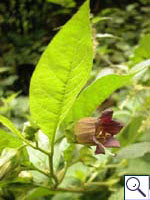|
||||||
|
ATROPA. Deadly Nightshade. [Solanaceae] |
|
|
Deadly Nightshade (A. belladonna), is the only species of Atropa recorded in Britain. It is a native species. Five British miners are recorded on Atropa. A key to the European miners recorded on Atropa is provided in Bladmineerders van Europa. |
|
Key for the identification of the known mines of British |
|
1a > Leaf-miner: A short, irregular, linear upper surface mine on any part of the leaf, indistinguishable from the mine of Liriomyza sativae. |
|
|
|
Liriomyza bryoniae (Kaltenbach, 1858) [Diptera: Agromyzidae]. |
|
1b > Leaf-miner: Mine linear, whitish, both upper and lower surface. Pupation internal, at the end of the mine with the anterior spiracles projecting through the epidermis (Spencer, 1976: 433). Upper-surface, less often lower-surface corridor. Frass in isolated grains. Pupation within the mine, usually in a lower-surface puparial chamber. A long whitish upper surface corridor, which eventually goes lower surface. |
|
|
|
Chromatomyia horticola (Goureau, 1851) [Diptera: Agromyzidae]. |
|
1c > Leaf-miner: Large blotch mine, often with several larvae, beginning with a short deeper corridor at a single egg shell on the surface of the leaf. The broad deep corridor later ends in a blotch but can be recognised (beneath the blotch) by its greater depth. Mine predominantly dorsal or ventral, greenish in transmitted light. Frass grains irregularly scattered except in the initial corridor. Blotch, mostly occupying almos the entire leaf, containing several larvae. Much, half-deliquescent, greenish-black frass. At the start of the mine at the leaf underside a group of some 5 elliptic egg shells, parallel to each other. However, the larvae can leave their mine and restart elsewhere, so mines without egg shells can occur as well. The larvae do not penetrate into the stem of the plant, neither is the mine full depth (compare Delia species). Mine indistinguishable from P. exilis or P. hyoscyami. Makes a large upper surface whitish blotch, which can contain several larvae. The frass has a washed out appearance and is greenish. There may be several mines on a leaf and eventually the leaf will be mined and then shrivel up. To identify this miner adults must be reared. |
|
|
|
Pegomya hyoscyami (Panzer, 1809) [Diptera: Anthomyiidae]. |
|
1d > Leaf-miner: Blotch mines, generally occupying an entire leaf, usually containing several larvae. Much, half deliquescent, green frass. Mine indistinguishable from P. exilis or P. hyoscyami. |
|
|
|
Pegomya betae (Curtis, 1847) [Diptera: Anthomyiidae]. |
|
1e > Leaf-miner: The larvae forms large whitish or translucent blotches. Rather large, untidy blotch, full-depth for most of its surface, very transparent, without feeding lines and without association with midrib or leaf margin. The larva makes several mines. Often only its anterior part is inserted in the mine, that remains free of frass then. Pupation outside the mine in a silk cocoon. |
|
|
|
Acrolepia autumnitella Curtis, 1838 [Lepidoptera: Acrolepiidae]. |
|
| Last updated 01-Jul-2019 Brian Pitkin | ||

